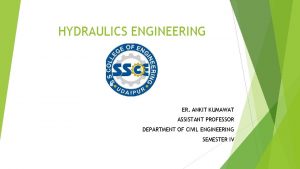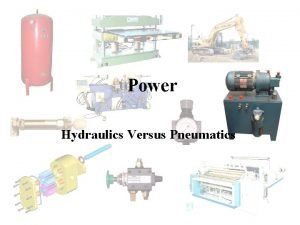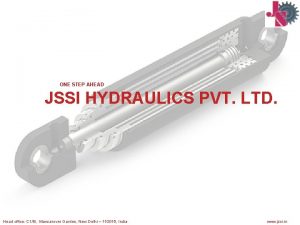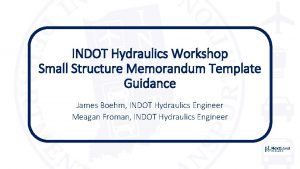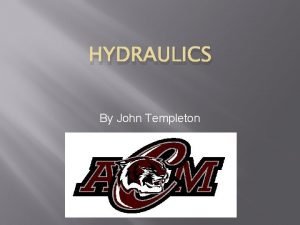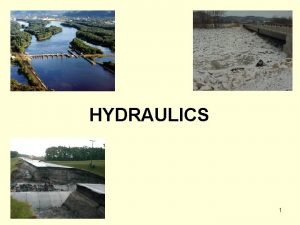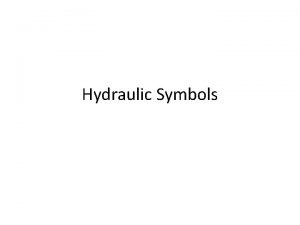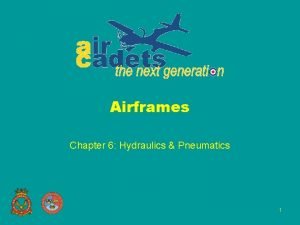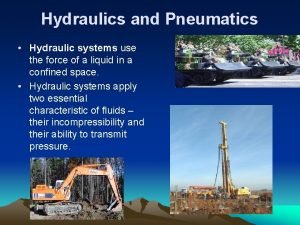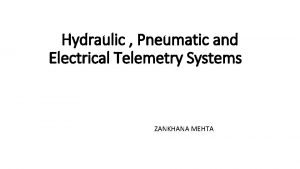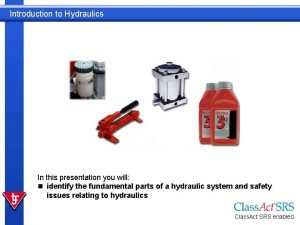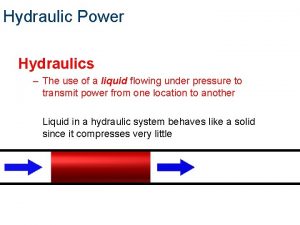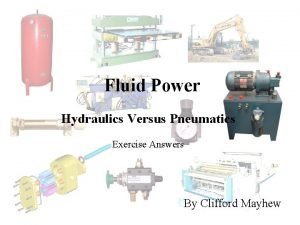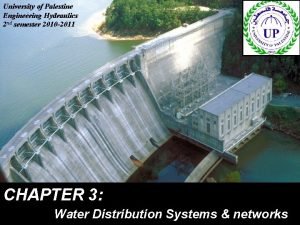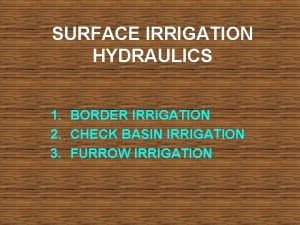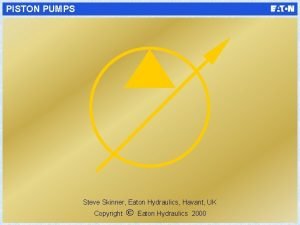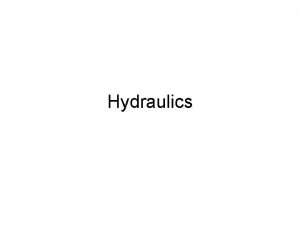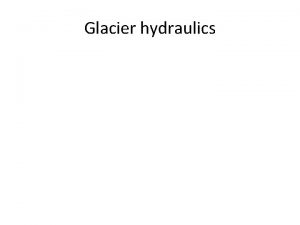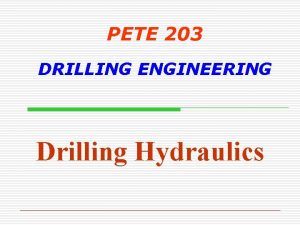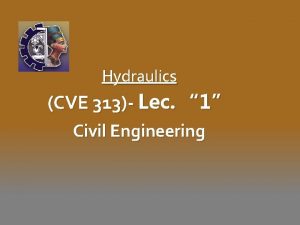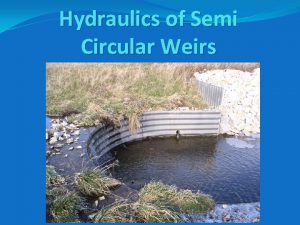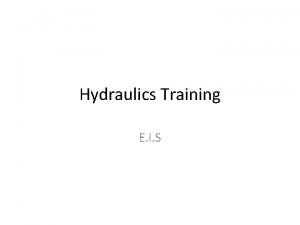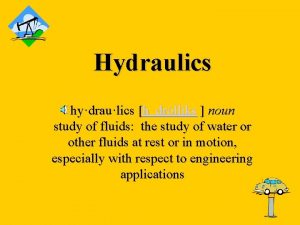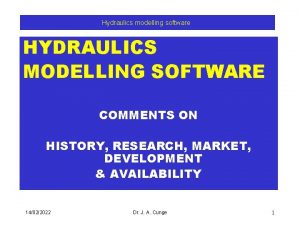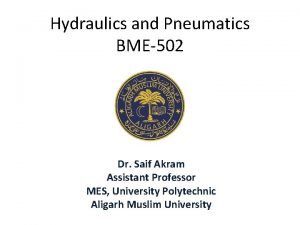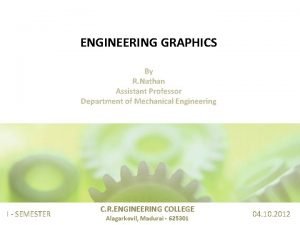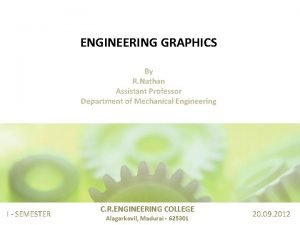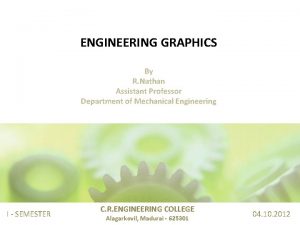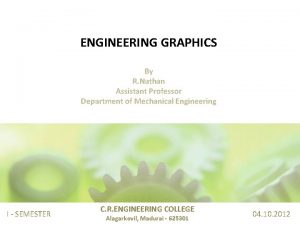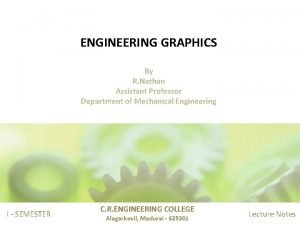HYDRAULICS ENGINEERING ER ANKIT KUMAWAT ASSISTANT PROFESSOR DEPARTMENT























- Slides: 23

HYDRAULICS ENGINEERING ER. ANKIT KUMAWAT ASSISTANT PROFESSOR DEPARTMENT OF CIVIL ENGINEERING SEMESTER IV

HYDRAULICS ENGINEERING Hydraulic Engineering is a sub-discipline of ‘Civil Engineering’ concerned with the flow and conveyance of fluids, principally water. This area of engineering is intimately related to the design of bridges, dams, channels, canals, and laves and to both sanitary and environmental engineering. Hydraulic engineering is the Science of water in motion and its interactions with the surrounding environment. The term 'Hydraulics' is related to the application of the Fluid Mechanics principles to water engineering structures, civil and environmental engineering facilities: e. g. , canal, river, dam, reservoir, water treatment plant. SSCE DEPARTMENT OF CIVIL ENGINEERING 2

Hydraulics in Civil Engineering Hydraulics is an important field in Civil Engineering that has to do with the mechanical properties of liquids. Whether the project is a tunnel, road or series of pipes running through a building. it’s important to know how the water will travel and what conditions the building will be safe under. Read more about topics like fluid mechanics, fluid machinery, irrigation, coastal waters and more. Some fluids have excellent flow properties which can be used for the lubrication of various machines. SSCE DEPARTMENT OF CIVIL ENGINEERING 3

Common Applications of Hydraulics Hydroelectric Power Plants Hydraulic machines Automobiles Refrigerators and Air Conditioners Thermal Power Plants Nuclear power plants Fluids as a Renewable Energy Source Operating Various Instruments SSCE DEPARTMENT OF CIVIL ENGINEERING 4

Topic study in Hydraulics Engineering Hydraulics Dimensional Analysis & Models Turbulent flow Boundary Layer Theory Gradually varied flow Hydrology Hydrologic cycle measurement of rainfall Run off Ground Water Rapidly varied flow Canal Hydraulics Hydraulic jump design of channels Impact of free Jets Introduction of Hydraulic machine SSCE DEPARTMENT OF CIVIL ENGINEERING 5

Elements of Hydraulic Engineering Specific Energy (Alternate Depths) Hydraulic Jump (Sequent Depths) SSCE DEPARTMENT OF CIVIL ENGINEERING 6

Energy in Open Channels SSCE DEPARTMENT OF CIVIL ENGINEERING Specific Energy 7

Specific Energy, E E = energy (head) measured with respect to the channel bottom E = V 2/2 g + y = q 2/(2 gy 2) + y Multiply through by y 2 and arrange to find y 3 – E y 2 + q 2/2 g = 0 SSCE DEPARTMENT OF CIVIL ENGINEERING 8

Specific Energy Diagram Rectangular channel: E=y B = 20 ft Q = 600 ft 3/s. Fr = 1 Fr = 2 Fr = V/(gy)0. 5 SSCE DEPARTMENT OF CIVIL ENGINEERING 9

Example: Sluice Gate q = 30 ft 2/s y = 5. 6 ft y = 1. 8 ft SSCE DEPARTMENT OF CIVIL ENGINEERING 10

Hydraulic jump Note that there is head loss in an hydraulic jump SSCE DEPARTMENT OF CIVIL ENGINEERING 11

jump Hydraulic jump on Rattan Creek, TX. July 2, 2002 strong jump: Fr > 9. 0, rough wavy surface downstream steady jump: 4. 5<Fr < 9. 0, stable and well-balanced SSCE DEPARTMENT OF CIVIL ENGINEERING 12

Classification SSCE DEPARTMENT OF CIVIL ENGINEERING 13

SSCE DEPARTMENT OF CIVIL ENGINEERING 14

SSCE DEPARTMENT OF CIVIL ENGINEERING 15

Now let’s consider an hydraulic jump We know that or SSCE DEPARTMENT OF CIVIL ENGINEERING 16

momentum balance Our momentum balance can be written as rearranging and dividing by g : Using A=By for a rectangular channel Let’s go back to our hydraulic jump… SSCE DEPARTMENT OF CIVIL ENGINEERING

solvable set If we have an open channel where we know Q, B, and y 1, we can solve for y 2 SSCE DEPARTMENT OF CIVIL ENGINEERING 18

rectangular Starting from Recalling the definition of the flow rate per unit width we can obtain Solving for y 2 y 1 solution is similar SSCE DEPARTMENT OF CIVIL ENGINEERING 19

limits Now, what are the limitations of this equation? • shear forces are neglected • shear causes smaller head loss than turbulence in the jump • requires jump occurs over a short distance • rectangular channel • effect of gravity downslope is neglected • again requires jump to occur over a short distance • neglect non-hydrostatic pressure • uniform density fluid 5/19/2021 20

what is the fundamental principle for this equation? conservation of momentum The more general head loss formula is Valid for any cross section SSCE DEPARTMENT OF CIVIL ENGINEERING 21

Conclusion In a rectangular open channel flume under the influence of various flow structures. Several experimental runs were accomplished to obtain Y 2 by measuring Y 1 and Q using different flow structures and various gate openings. The measured values of Y 2 disagree with the simulated results of former equations. Also, the measured Y 2 varies by varying the flow structure for the same Y 1 and Q that reveals that the former equations of hydraulic jump should be modified to show the impact of shear force due to friction between hydraulic jump and bed of water canals. SSCE DEPARTMENT OF CIVIL ENGINEERING 22

Thank you SSCE DEPARTMENT OF CIVIL ENGINEERING 23
 Hydraulic engineering
Hydraulic engineering Ankit kumawat
Ankit kumawat Ankit saxena
Ankit saxena Ankit agarwal coinbase
Ankit agarwal coinbase Define sreyas
Define sreyas Promotion from associate professor to professor
Promotion from associate professor to professor Cuhk salary scale 2020
Cuhk salary scale 2020 Hydraulics and pneumatics symbols
Hydraulics and pneumatics symbols Jssi hydraulics pvt. ltd
Jssi hydraulics pvt. ltd Indot hydraulics
Indot hydraulics Hydraulics definition
Hydraulics definition Hydraulics definition
Hydraulics definition Pilot line hydraulics
Pilot line hydraulics Storehouse with fluid tanks
Storehouse with fluid tanks Pneumatics vs hydraulics
Pneumatics vs hydraulics Introduction to hydraulics and pneumatics
Introduction to hydraulics and pneumatics Pneumatic telemetry system
Pneumatic telemetry system Introduction to hydraulics and pneumatics
Introduction to hydraulics and pneumatics Hydraulics
Hydraulics Hydraulics and pneumatics quiz
Hydraulics and pneumatics quiz Palestine hydraulics
Palestine hydraulics Basin irrigation definition
Basin irrigation definition Eaton havant
Eaton havant Hydraulics
Hydraulics
